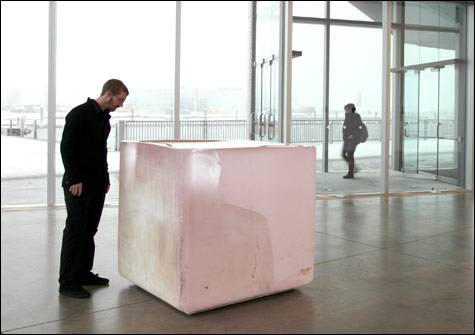
PINK TONS Horn’s is a kinder, gentler, more crowd-pleasing Minimalism. |
"I've been told it's the largest single piece of glass in the world," Helen Molesworth, the Institute of Contemporary Art's new chief curator, said at a press preview last week. The object in question — Roni Horn's four-foot-tall, five-ton pink glass cube Pink Tons (2008) — is now sitting in the ICA's lobby as part of "Roni Horn aka Roni Horn," a show organized by New York's Whitney Museum and London's Tate Modern and representing the New Yorker's "first comprehensive" career survey.
Pink Tons' sides are frosty, with clear icy cracks at the corners. From certain angles, the cube looks as if it were filled with water, almost to overflowing. Look in the clear top and you can see a large wave seeming to ripple inside.
One way to define Modern Art is as a seven-decade project to break art down to its atomic elements — from Picasso's Cubism to Jackson Pollock's drips to Ad Reinhardt's all-black paintings. Arriving in the 1960s, near the end of this lineage, was Minimalism, which favored basic geometric forms, industrial materials, and repetition. Minimalism is best known for its sculptures — Carl Andre's grids of metal tiles displayed right on the gallery floor, Tony Smith's six-foot-tall steel cube Die from 1968. These works presented objects in it-is-what-it-is fashion, focusing on the space they share, and the subtle relationships among viewers. It was usually severe, hard-edged, macho, buttoned-up stuff predicated on the notion that if you concentrated on it hard enough and were worthy, you might attain transcendence.
More than four decades later, Minimalism remains one of the primary modes of operation in the art world. And over the past couple of years, the ICA's big solo-artist surveys have catalogued its permutations, from Anish Kapoor's quicksilver holes-to-another-dimension to Tara Donovan's seas of plastic cups and other magical home-ec accumulations to Damián Ortega's disassembled Volkswagen and piles of bricks. It wasn't hard to spot descendants of Smith's Die. Donovan's show included a gravity-defying cube of straight pins. Ortega presented mirrored steel cubes.
This is a kinder, gentler, more crowd-pleasing Minimalism. The shift in tone is partly just what happens when people fiddle with the same idea for four decades. But some of it has to be credited to '70s Feminism — it opened the door for works like Pink Tons, which retains Minimalism's signature bad-ass scale, geometry, and industrial materials but is warmer, more dramatic, more curvy, more pink.
Horn's sculptures, photos, and drawings are spare, delicate, just-so. The ICA show includes a four-foot-tall ant farm (1974/2007), a dull-gray ball sitting in the middle of a dull-gray concrete floor (1988/2001), and — propped against the walls of one gallery — a series of industrial-aluminum-and-cast-plastic rods (2006/2007) featuring lines from Emily Dickinson poems: "Faith is doubt," "Nature is so sudden she makes us all antique." There are then-and-now photos of Horn at various ages, doodly abstract drawings, and dozens of similar head shots of a stern-faced young blonde woman apparently bobbing in blue water.